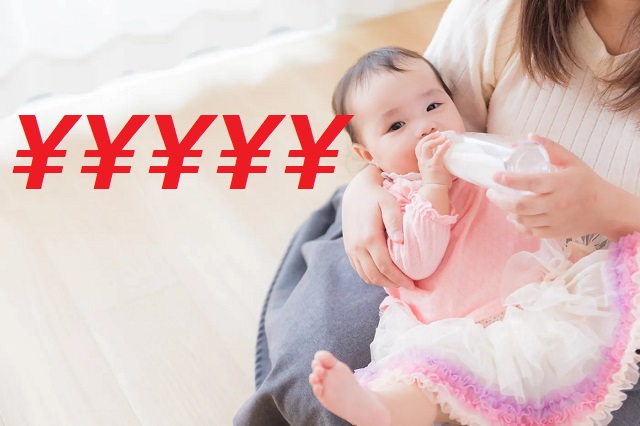
And if you have another kid after that? Another two million yen.
Notice: This article was originally published incorrectly stating that the total grant was 20 million yen. The writer responsible has been whacked upside the head for their negligence, and SoraNews24 sincerely apologizes to anyone who became pregnant before the error was corrected.
Japan’s birthrate has been slumping for decades, and while anyone packed into a crowded Tokyo commuter train might momentarily be fine with the concept of fewer people, long-term it presents problems for Japan’s pension, health insurance, and other social welfare and economic systems.
Because of that, both the national and local governments are constantly investigating new initiatives to encourage people to start cranking out more kids, and the latest plan from the city of Sado, Niigata Prefecture, is to give parents two million yen (US$18,180) for having a third kid, and also for each additional kid after that.
That’s not to say that a city official shows up in the delivery room with a stack of 200 10,000-yen bills, though, since the grant is meant to help with the costs of both child rearing and education. The parents receive a payment of 200,000 on the occasion of the child’s birth followed by sums of 400,000, 500,000, and 800,000 yen when they turn 6, 12, and 15 years old, roughly aligning with the ages when they start elementary, middle, and high school (as high school is not part of compulsory education in Japan, even public high schools charge tuition). Combined with a separate Sado program started earlier in the year that gives a 100,000-yen grant for any birth in the city, the total payment for each third or later child comes out to two million yen.
▼ “You’re welcome, Mom and Dad.”
But why start the surge at the third child? Because of the results of a survey Sado conducted last year among households in the city who already have children, which asked them how large of a family they’d ideally like. More than half of the respondents said they’d like to have three kids, but many also said that such a large family would be economically difficult for them.
Sado’s strategy of focusing on families that already have children makes a certain kind of sense. As Japanese lifestyles continue to evolve and become more diverse, there’s comparatively less social pressure to have children than there was in previous generations, and thus a larger number of people who simply aren’t interested in having kids of their own. Respecting their freedom to make that choice, and instead concentrating on couples who’ve already decided they want to be parents but are hesitant to expand their brood because of budgetary concerns, sounds like a win-win.
On the other hand, one could argue that waiting until the third child for the major economic support to kick in makes it harder for childless couples to make that first, or even second, step into parenthood, and that spreading the benefits more evenly among births could lower that entry barrier.
Still, for couples who would like big family, two million yen is a lot of money, and Sado hopes that the program not only promotes births among its current households, but also helps convince people from other parts of Japan to move to the city and raise their children there. And if nothing else, it sounds like a better plan than relying on parental nagging or A.I. matchmakers.
Source: NHK News Web
Top image: Pakutaso (edited by SoraNews24)
Insert image: Pakutaso
● Want to hear about SoraNews24’s latest articles as soon as they’re published? Follow us on Facebook and Twitter!
Follow Casey on Twitter, where he’d like to apologize or not not earning two million yen for his parents at the moment of his birth.


 Tokyo’s latest plan to boost birth rate: Pay people 100,000 yen per baby they give birth to
Tokyo’s latest plan to boost birth rate: Pay people 100,000 yen per baby they give birth to Japanese government wants to give people an extra 80,000 yen to have babies, but will it work?
Japanese government wants to give people an extra 80,000 yen to have babies, but will it work? Japan’s Japanese population dropping in every part of the country, foreign population rising
Japan’s Japanese population dropping in every part of the country, foreign population rising If Japanese men “have their act together,” Japanese women will reward them with babies, politician says
If Japanese men “have their act together,” Japanese women will reward them with babies, politician says Japanese government to start giving newlywed couples a wedding gift of 600,000 yen
Japanese government to start giving newlywed couples a wedding gift of 600,000 yen Starbucks Japan ready to get Year of the Horse started with adorable drinkware and plushies【Pics】
Starbucks Japan ready to get Year of the Horse started with adorable drinkware and plushies【Pics】 We found possibly the quietest Japanese-style hotel in Tokyo’s bustling Shinjuku district
We found possibly the quietest Japanese-style hotel in Tokyo’s bustling Shinjuku district Lace boxer briefs for men: Japanese company creates underwear that’s beautiful and functional
Lace boxer briefs for men: Japanese company creates underwear that’s beautiful and functional 7 great places to see Mt. Fuji from without having to climb it
7 great places to see Mt. Fuji from without having to climb it Peeing Shiba Inu figures are Japan’s latest quirky, maybe-cute capsule toy offerings【Photos】
Peeing Shiba Inu figures are Japan’s latest quirky, maybe-cute capsule toy offerings【Photos】 Giant Clodsire Pokémon plushie comes with up to 32 Woopers in super size, super cute set【Pics】
Giant Clodsire Pokémon plushie comes with up to 32 Woopers in super size, super cute set【Pics】 Sakura Ride Plan: A new way to see the best cherry blossom sites in Tokyo
Sakura Ride Plan: A new way to see the best cherry blossom sites in Tokyo Gundam creator isn’t making his new series for you, doesn’t care if you don’t like it
Gundam creator isn’t making his new series for you, doesn’t care if you don’t like it We try to buy a retro Japanese coin-operated arcade machine at this secondhand shop near Tokyo
We try to buy a retro Japanese coin-operated arcade machine at this secondhand shop near Tokyo Possibly the most elegant chicken and waffles restaurant ever opens in Kyoto
Possibly the most elegant chicken and waffles restaurant ever opens in Kyoto Lacquerware supplier to emperor of Japan and Pokémon team up for new tableware
Lacquerware supplier to emperor of Japan and Pokémon team up for new tableware Japan may add Japanese language proficiency, lifestyle classes to permanent foreign resident requirements
Japan may add Japanese language proficiency, lifestyle classes to permanent foreign resident requirements 7-Eleven Japan’s ramen-cooking robot whipped us up a bowl of noodles【Taste test】
7-Eleven Japan’s ramen-cooking robot whipped us up a bowl of noodles【Taste test】 Cyberpunk anime meets traditional culture in Ghost in the Shell gold leaf Japanese changing screens
Cyberpunk anime meets traditional culture in Ghost in the Shell gold leaf Japanese changing screens Disillusionment at Tsukiji’s tourist-target prices led us to a great ramen restaurant in Tokyo
Disillusionment at Tsukiji’s tourist-target prices led us to a great ramen restaurant in Tokyo Hello Kitty Choco Egg figures are an adorable trip through three periods of Japanese pop culture【Pics】
Hello Kitty Choco Egg figures are an adorable trip through three periods of Japanese pop culture【Pics】 Starbucks Japan releases new zodiac chilled cup drink for 2026
Starbucks Japan releases new zodiac chilled cup drink for 2026 Japan’s otoshidama tradition of giving kids money at New Year’s gets a social welfare upgrade
Japan’s otoshidama tradition of giving kids money at New Year’s gets a social welfare upgrade 7-Eleven Japan starts new temporary luggage storage service in over 300 branches
7-Eleven Japan starts new temporary luggage storage service in over 300 branches Starbucks teams up with 166-year-old Kyoto doll maker for Year of the Horse decorations【Photos】
Starbucks teams up with 166-year-old Kyoto doll maker for Year of the Horse decorations【Photos】 Tokyo considering law requiring more trash cans following litter increase in heavily touristed area
Tokyo considering law requiring more trash cans following litter increase in heavily touristed area Tokyo’s Tsukiji sushi neighborhood asks tour groups to stay away for the rest of the month
Tokyo’s Tsukiji sushi neighborhood asks tour groups to stay away for the rest of the month Nintendo’s Kirby now delivering orders at Kura Sushi restaurants, but not in Japan
Nintendo’s Kirby now delivering orders at Kura Sushi restaurants, but not in Japan Tokyo event lets you travel back in time, for free, to celebrate 100 years since Showa era start
Tokyo event lets you travel back in time, for free, to celebrate 100 years since Showa era start Sanrio theme park in Japan announces plans to expand into a Sanrio resort
Sanrio theme park in Japan announces plans to expand into a Sanrio resort Stamina-destroying “Paralysis Noodles” are Tokyo’s newest over-the-top ramen innovation
Stamina-destroying “Paralysis Noodles” are Tokyo’s newest over-the-top ramen innovation Survey asks foreign tourists what bothered them in Japan, more than half gave same answer
Survey asks foreign tourists what bothered them in Japan, more than half gave same answer Japan’s human washing machines will go on sale to general public, demos to be held in Tokyo
Japan’s human washing machines will go on sale to general public, demos to be held in Tokyo Japan’s deadliest food claims more victims, but why do people keep eating it for New Year’s?
Japan’s deadliest food claims more victims, but why do people keep eating it for New Year’s? We deeply regret going into this tunnel on our walk in the mountains of Japan
We deeply regret going into this tunnel on our walk in the mountains of Japan Studio Ghibli releases Kodama forest spirits from Princess Mononoke to light up your home
Studio Ghibli releases Kodama forest spirits from Princess Mononoke to light up your home Major Japanese hotel chain says reservations via overseas booking sites may not be valid
Major Japanese hotel chain says reservations via overseas booking sites may not be valid Put sesame oil in your coffee? Japanese maker says it’s the best way to start your day【Taste test】
Put sesame oil in your coffee? Japanese maker says it’s the best way to start your day【Taste test】 No more using real katana for tourism activities, Japan’s National Police Agency says
No more using real katana for tourism activities, Japan’s National Police Agency says Starbucks Japan reveals new sakura drinkware collection, inspired by evening cherry blossoms
Starbucks Japan reveals new sakura drinkware collection, inspired by evening cherry blossoms Updated cherry blossom forecast shows extra-long sakura season for Japan this year
Updated cherry blossom forecast shows extra-long sakura season for Japan this year Medical bills to be free in all Tokyo wards for high school students, younger kids from next year
Medical bills to be free in all Tokyo wards for high school students, younger kids from next year Japanese government to give all 18-and-under residents 100,000 yen… here’s why that’s bad news
Japanese government to give all 18-and-under residents 100,000 yen… here’s why that’s bad news Rethinking of gender roles is a “prerequisite” for raising Japan’s birth rate, experts say
Rethinking of gender roles is a “prerequisite” for raising Japan’s birth rate, experts say Japanese government’s new birth rate plan: Use AI to tell people who’d be a good spouse for them
Japanese government’s new birth rate plan: Use AI to tell people who’d be a good spouse for them Population aging in Japan gets a corona-boost as pregnancies drop by 11 percent this year
Population aging in Japan gets a corona-boost as pregnancies drop by 11 percent this year Japanese politician’s birthrate plan: Have parents nag their kids to have “at least three babies”
Japanese politician’s birthrate plan: Have parents nag their kids to have “at least three babies” Top five Japanese prefectures for childhood education expenditure would make any wallet shudder
Top five Japanese prefectures for childhood education expenditure would make any wallet shudder Lots of Japanese parents want their kids to work for Nintendo, but not just for the money, survey says
Lots of Japanese parents want their kids to work for Nintendo, but not just for the money, survey says You can now buy bully insurance for your kids in Japan
You can now buy bully insurance for your kids in Japan Parents of 10-year-old in Kyoto who spent 4.6 million yen on TikTok and more seek reimbursement
Parents of 10-year-old in Kyoto who spent 4.6 million yen on TikTok and more seek reimbursement 6 surprising things about having a baby in Japan
6 surprising things about having a baby in Japan Living costs of Tokyo families now average 23.5 million yen over half a lifetime
Living costs of Tokyo families now average 23.5 million yen over half a lifetime What do Japanese kids spend their allowance on? Survey finds out
What do Japanese kids spend their allowance on? Survey finds out Checking in on randoseru school bags and the changing tastes of Japanese kids
Checking in on randoseru school bags and the changing tastes of Japanese kids Japanese government plans to pay women who move out of Tokyo to get married 600,000 yen【Report】
Japanese government plans to pay women who move out of Tokyo to get married 600,000 yen【Report】
Leave a Reply